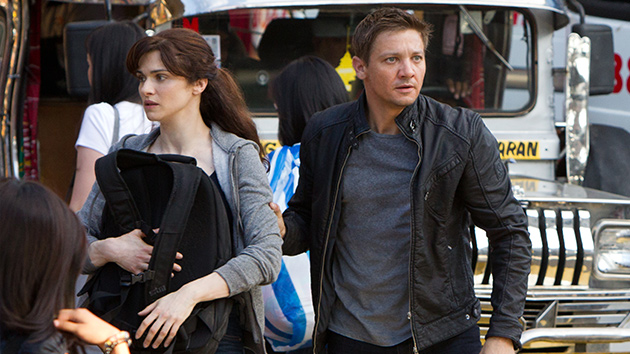Temping VFX, Focusing on Sound, and Fitting Big Action Scenes into a Tight Schedule
Everyone working on The Bourne Legacy had a tough job. Director Tony Gilroy—a writer or co-writer on all four films—had to reinvent a world he helped create. Star Jeremy Renner, playing Aaron Cross, had to measure up to the super-soldier standard set by Matt Damon as Jason Bourne. Cinematographer Robert Elswit, ASC, needed to put his own stamp on the material, dialing back the jittery camerawork of previous DP Oliver Wood and director Peter Greengrass. And editor John Gilroy, Tony’s brother, had to keep up with an accelerated schedule that demanded he stay absolutely on top of the footage as it was being shot.
“We had a long shooting schedule and a very short post schedule,” Gilroy says. “I only had 10 real weeks to put the thing to bed after we stopped shooting. So we were working hard from the get-go, and moving quickly.”
The shoot started in New York, where sets were built at Kaufman Astoria Studios in Queens. Gilroy’s team at that point included first assistant editor James W. Harrison III, second assistant Ian Blume, apprentice Andrew Levin, and VFX editor Kent Blocher. The size of the team expanded until, near the end of post-production, close to 15 editors were each working on an Avid Media Composer connected to a Unity shared storage network. When the production moved into the Canadian Rockies for about 12 shooting days, Gilroy didn’t tag along physically, but he was there in spirit, using the telephone and Skype to keep in touch with the director on a daily basis. After a break in shooting over the Christmas holiday, the production moved to the Philippines. Gilroy stayed behind at first, getting more work done before packing his bags. Then, Gilroy and first assistant Harrison set up a couple of Avids in a hotel room near the shoot, where they could consult closely with the director during the final weeks of principal photography.
We asked Gilroy about editing for speed, After Effects in the cutting room, and completing a major Hollywood action movie with his brother.
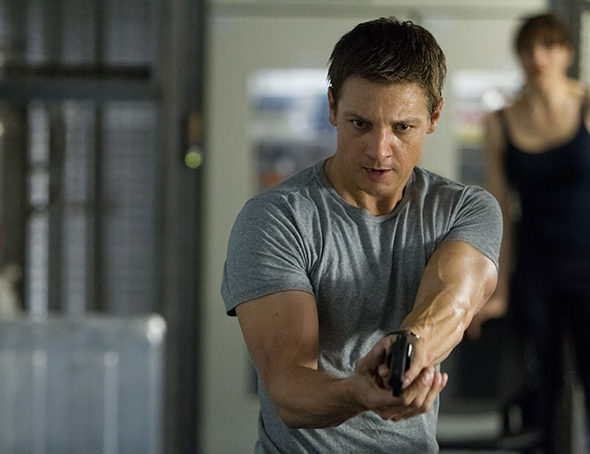
id=”attachment_26101″ align=”alignnone” width=”590″ caption=”Still from The Bourne Legacy showing Aaron protecting Marta in her house”
StudioDaily: You’ve edited all three of the films your brother Tony has directed to date. Can you talk a little bit about that relationship?
John Gilroy: We both had our own careers, and we had never really worked together before Michael Clayton. When it came up it seemed logical that we would work together. People would say, ‘Well, how are they going to get along?’ But we always got along. We have a very similar sensibility and it’s a pleasure working with him. It’s totally organic.
The Bourne films have a very distinct style, especially the last two with director Peter Greengrass, which pushed the quick-cutting, shakycam style to its limits. Did you react to that in any way in your work on this film?
There were definitely conversations about it. Tony has a very strong relationship with [director of photography] Robert Elswit, who shot both of his other films, and the three of us talked about it. I try to let a director and a DP get married, in a sense, at the beginning of a project, and I weigh in. So we had conversations about the look of the film and Tony and Robert felt they wanted to give the film its own signature style, and they didn’t want to imitate the other films. And once they chose a way to shoot the film — if you’re going to make a film look like the other Bourne films, you have to shake the camera and shoot with five cameras, and there were a lot of times when they didn’t shoot like that. And the style they shot with would dictate the way I put it together.
As you worked, did the way a certain sequence came together ever influence you to go back and try a different approach with another part of the film?
There’s always an evolution, but I don’t tend to cut very loose. I don’t cut a “rough assembly” if I can help it. If I have a good sense of what the director wants and we’re clear on performance, it starts with each scene — really lavishing attention on individual scenes, getting them into a good place, and moving on to the next scene. If you do that, you’re not really rough-cutting the film. You do end up with a cut that’s longer, because you include everything on the first pass. As you build, you start to realize, “Gee, we probably don’t need that scene. And now that we have a better perspective, we can take this away, too.” We’ll do that as we go. But even on the initial cut, I’m doing that. I’m amending the film, with Tony’s blessing. You ask, “What if we did this” and “What if we did that?” Things are occurring to you that you need, or that might be helpful. It could be a transition or an insert, or it could be a piece of dialogue.
That’s why it’s important for you to be in close contact during the shoot — to make sure you can ask for those things before the sets come down.
Yes, that’s a big deal. I’ve worked on smaller films, and in the independent film world, they often hire the editor after the shoot and think they’re saving themselves money. And I think, “Oh no — now you don’t have anyone to tell you when you’re missing something.”
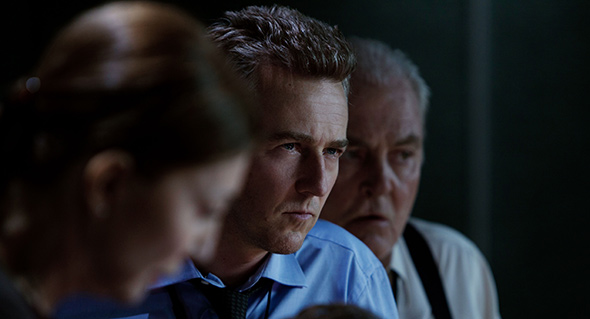
id=”attachment_26105″ align=”alignnone” width=”590″ caption=”Edward Norton in The Bourne Legacy”
The first couple of reels of this film take place contemporaneously with some of the events of the previous Bourne film, which is an unconventional way to frame a sequel. Was there any discussion about how you would finesse that and make sure the audience was understood the timeline?
That’s one of the really crafty things about this script! Tony wrote the script with my twin brother Danny, and they purposefully had these timelines overlapping so they could access certain intersection points between Jason Bourne’s story and Aaron Cross’s story. That was genius, and a lot of it is in the script. What I contributed was that I got the Bourne Ultimatum film library from the studio and put that in my Avid. It was a whole parallel library. I went through to see what they had shot that would dovetail with the intersecting points in the stories. We didn’t use much of it, but I did access their footage to enhance things like Simon Ross [the investigative journalist from The Bourne Ultimatum] getting clipped at Waterloo Station. Little things like that are kind of neat, going back and forth between the two films, but once you’re past the first 25 or 30 minutes of the movie, you’re into our story.
Were there any situations where you wanted to go back and change your approach to an edited scene based on how something else came together later in the project?
The only thing was the whole mission-control aspect of the film. All the Ed Norton stuff in the crisis suite was shot first. As we were amending story points and other things, that became a storytelling device for the film. In a perfect world we would have had some shooting days on the back end [to return to that part of the shoot]. There’s a little bit of sleight of hand here and there. But Tony is a very tight writer. His blueprints are pretty magnificent. You do what you have to do in the cutting room to rewrite a movie and make it work. But I do less of that with his films than I have with other directors. And this was a big step in his evolution as a director. There was a lot of previs to really think things out, and Tony hired Dan Bradley, a genius with action, as second-unit director. It was a pleasure putting all that stuff together.
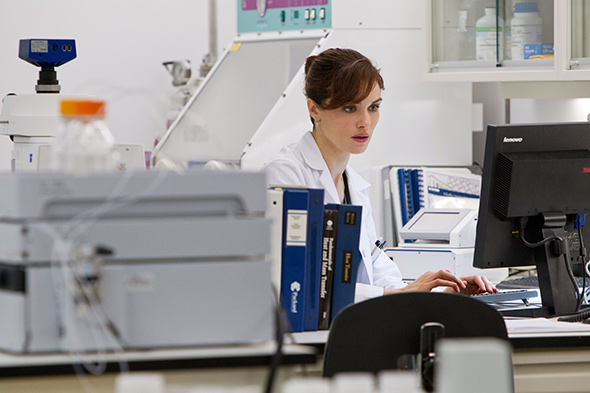
id=”attachment_26097″ align=”alignnone” width=”590″ caption=”Still from The Bourne Legacy showing Rachel Weisz in the lab”
One of the film’s standout set pieces involves a scientist going on a rampage with a pistol in a locked room. Can you talk about how you edit a scene like that to maximize tension and horror?
It was very subliminal — a tonal thing. What carries it sonically is a droning alarm that Marta [Rachel Weisz’s character] presses, and that’s the music for it. Kevin Thompson, the production designer, built that magnificent set — it was 30 feet through a wall in my cutting room on the soundstage — and they walked through it doing the blocking and working out the logic of it all. One of the things that distinguishes that set piece, and the one where the agents are in Marta’s house trying to kill her, is that attention is really paid to geography. Sometimes action sequences are full of quick cutting and you don’t know exactly where you are. That lab shooting is a slow, deliberate scene and it started with a great set that they walked through with the idea of keeping it real and not trying to make it overly sensational. The more realistic it was, the more haunting and impactful it would be. When we got the dailies back, I worked on that scene very hard and very quickly to get it buttoned down early on so we could make sure we had everything we needed.
I suppose Rachel Weisz’s performance helped hold that scene together, too.
I am a huge fan of hers. She was great. It was really easy to put it together.
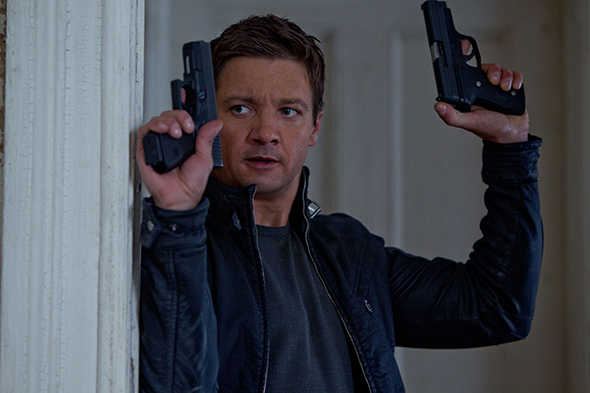
id=”attachment_26107″ align=”alignnone” width=”590″ caption=”Image of Aaron Cross with two guns raised from The Bourne Legacy”
You mentioned the scene that takes place in her house, and I was wondering about the shot where Aaron Cross scales the side of that house to enter an upper-story window. It seemed like that shot was designed with some invisible edits to get him up and in there.
The house is interesting. There was a real house they scouted in Hudson, New York. It was great. But it wasn’t structurally sound. It was really dilapidated and falling down. So, at the eleventh hour, they decided to build the interior of that house in Queens. All the interiors of that house are on a soundstage, so there was a lot of green-screen work for the windows. For that stunt, he’s actually outside, in Hudson, running, and then there’s an invisible cut point as he goes through the window, which was done on the soundstage in Queens. It looks like one shot but it’s actually two. We had the first piece, and we did the B side of it until it looked close enough, and then the VFX department did their magic to make it one piece.
How much of your job involves working on things like that in the Avid to make sure they’re in good shape before you hand them off to VFX?
It’s really become a thing over the last four or five years. When you’re putting something together, you don’t want to have a bunch of IOUs. My assistants use Adobe After Effects a lot for doing things like filling in green screens and muzzle flashes on guns. Those are all temp effects that are replaced eventually, but they actually look pretty good. There are certain things you can’t do, and we can’t join those two shots to look like one the way they can. But I do as much as I can within the context of After Effects so we’re not waiting around. And what we do can even inform the VFX department.
What about sound? Are you doing more with sound before that’s handed off to the mixers?
Sound is really important to me. I’m sure there are a lot of other editors who do a lot of sound work, but I know I do a lot of mine. You can carry 16 tracks in the Avid, and I’m doing cursory sound design as I’m cutting. It’s good for presentation purposes, and it really helps me understand the movie that much more. If things don’t work out or I need a little bridge, I have a mic on my Avid in case I have to amend a line. I’ll record it and show it to Tony and if he agrees, or if he rewrites it, then we have the actors do it.
The most chaotic part of the movie is probably the final action scenes that take place in the Philippines [watch the clip, above]. What was it like cutting those sequences, compared to the rest of the film?
That was kind of a drag for me. We were doing the biggest, most complicated action stuff at the very end of our schedule, and Manila was a problematic place to shoot. It’s just hard, logistically. I really had to hunker down to put stuff together really quickly so we could meet our VFX deadlines and have the movie ready to present to the public. But it’s funny. This movie followed a different convention from the other Bourne movies, but at the end it sort of turned into those movies. The last half-hour is very kinetic, and very much like the Bourne movies of old. In its own way, it morphs into them — and that’s fun.
